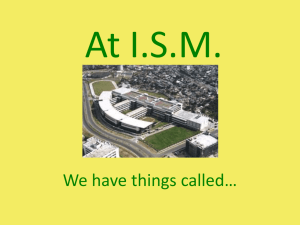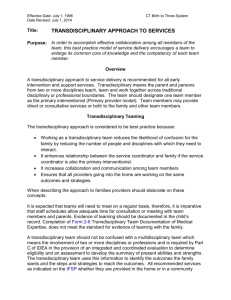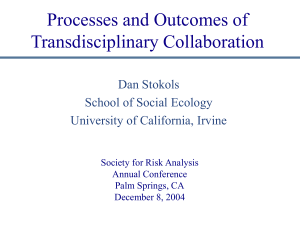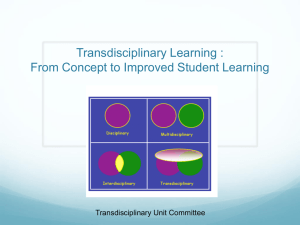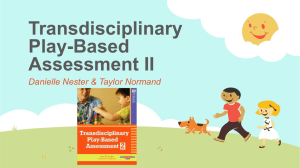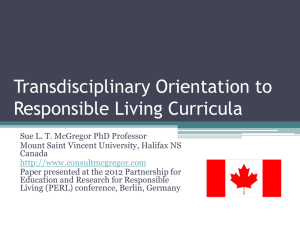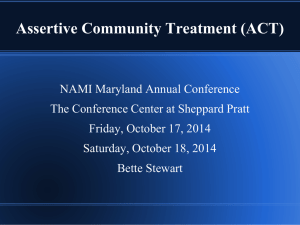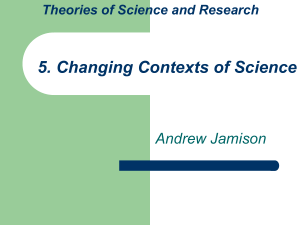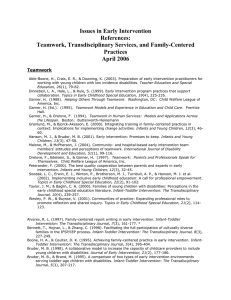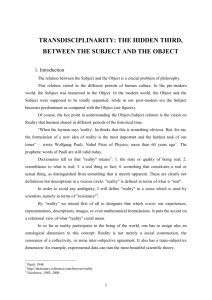The Morris Center`s Transdisciplinary model of Assessment
advertisement
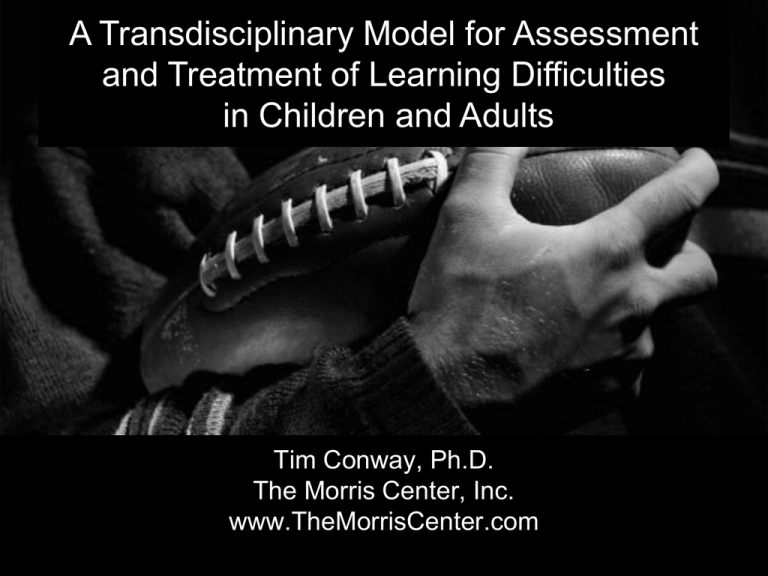
A Transdisciplinary Model for Assessment and Treatment of Learning Difficulties in Children and Adults Tim Conway, Ph.D. The Morris Center, Inc. www.TheMorrisCenter.com Transdisciplinary • two or more disciplines pool their approaches/knowledge and modify them, so that by working together they are better able to improve/treat the “problem” or “weak” skills. Transdisciplinary Assessment & Treatment Program for Learning Disabilities Overview of Services • Intake/Screening Appointment • Phase I Assessment • Phase II Assessment • Treatment • Post-treatment Assessment • Follow-up/Generalization 1933 Learning Disabilities - Reading • • • • • Dys = difficulty & Lexia = words Poor skills in Reading Neurological in origin Lifelong, but environment may alter course Core deficit in Phonological Component of Language • Accompanying Challenges (~50%) – ADHD – Sensorimotor – Behavior problems Transdisciplinary Team • Disciplines on the team – Pediatrician/Psychiatrist – Nursing/Nurse Practitioner – Psychology/Neuropsychology – Occupational Therapy – Speech-Language Pathology – Teacher/Special Education Transdisciplinary Assessment • Intake/Screening Appointment with Director – Collection of records – Identify presenting concern(s) – Provide scope and sequence of assessment and treatment program, timeline of program, associated costs,… – Provide research/educational data, identify additional community resources, etc … – Determine fit for The Morris Center’s services and client’s needs 1960 Transdisciplinary Team Assessment Two Phase Assessment Phase I: Broad Neurodevelopmental Evaluation & Medical History Phase II: Assessment of Specific Abilities to Identify an Individual Profile of Strengths & Weaknesses (for diagnostic and treatment planning purposes) Transdisciplinary Team Assessment • Phase I Evaluation (broad screening) – Neurodevelopmental evaluation • Medical and Developmental History & Exam • Screening of all brain systems including neuromotor, perception, learning, attention, speech, language, memory, motor planning and cognition. • Nutrition, sleep, behavior, allergies, medical… – Psychological evaluation • Diagnostic interview – psychosocial, educational, behavior, & family history. Transdisciplinary Team Assessment • Phase I Assessment Team members: – Nurse Practitioner or DevelopmentalBehavioral Pediatrician – Clinical Psychologist or Pediatric Psychiatrist – Director of The Morris Center Transdisciplinary Team Assessment • Phase II – in-depth assessment to identify an individual’s specific areas of strength and weakness that may contribute to presenting concerns or difficulties: – – – – – – – – Attention/Intention Intelligence/Cognition Oral Language Memory Sensorimotor Written Language Mathematics Behavioral Observations Transdisciplinary Team Assessment • Phase II Team Members – – – – – – – Clinical Psychology Neuropsychology Occupational Therapy Speech Language Pathology Educational Specialist Nursing Psychometrist Transdisciplinary Treatment Program • Key treatment features are based on neuroscience and behavioral treatment research findings – Intensity (# of hours per day) – Frequency (# of days per week) – Specificity (clarity of treatment program) • Ongoing data collection of program effects for program self-evaluation • Selective post-treatment assessment with standardized tests to document treatment gains Transdisciplinary Treatment Program Treatment targets within an Transdisciplinary model: • Speech-Language Therapy – Targets improving foundational language skills that may cause the learning difficulty, e.g. phonological processing/decoding • Occupational Therapy – Targets sensory and motor skills that may contribute to learning difficulties, e.g. sensory defensiveness, visual processing/perception, etc. • Psychiatric/Medical – Medication and behavioral management of attention, mood or behavior disorders. • Psychological Treatment – Client • e.g. developing adaptive coping skills for academic and life stressors – Parent • e.g. better behavior management, conflict resolution training, etc… – Client & Parent/Spouse (separately or combined) • Developing adaptive family or marital functioning, relative to learning difficulties. Treatment - Case Study • • • • High school student History of dyslexia Years of school-based academic intervention Years of reading tutoring – commercial centers, by private 1:1 tutors… – a family member was an ESE Reading Specialist • A first-team athlete • Weak skills in: – – – – – reading (>5 years below grade), writing & spelling comprehension auditory and visual memory visual-spatial attention Treatment - Case study • Transdisciplinary Phase I & II assessments identified weaknesses in: – Language • poor phonological processing, reading, spelling and comprehension – Occupational Therapy • sensory integration deficits including poor praxis, vestibular, visual vigilance, visual tracking, and visual processing – Medical • poor attention, as exhibited by difficulty maintaining attention to relevant visual and auditory stimuli Transdisciplinary Treatment Program • Individualized, Transdisciplinary treatment – Speech-Language Therapy – Occupational Therapy – Clinical Psychology/Counseling • Intensive, Frequent and Explicit Treatment – 22-25 hours of language treatment per week • 5 days/week for 4-5 hours/day – 1 hour of counseling per week – 1 hour of parent education per week – 5 hours of occupational therapy per week • 12 weeks of 1:1 Transdisciplinary treatment – (duration of treatment is client dependent) Documented Treatment Results • Selective re-administration of pre-treatment standardized, nationally normed-tests for measurement of post-treatment gains. • Graphical representation shows pre-treatment scores as blue stars and post-treatment scores as green stars • Green arrows indicating areas of significant gain or improvement. pre-treatment skills post-treatment skills Transdisciplinary Assessment and Treatment Goals • Identify and then improve weak skills to develop new strengths in: – – – – Language Sensorimotor Cognition/attention Behavior • Develop independent functioning in language, sensorymotor, behavior & achievement, relative to an individual’s true potential. • Provide essential “tools” for success in academic, occupational and interpersonal domains of life. Thank You www.TheMorrisCenter.com

